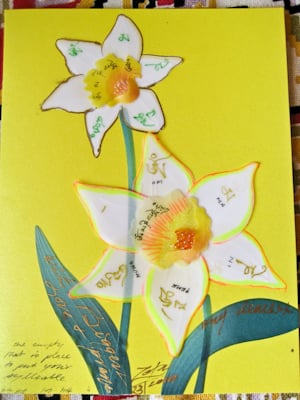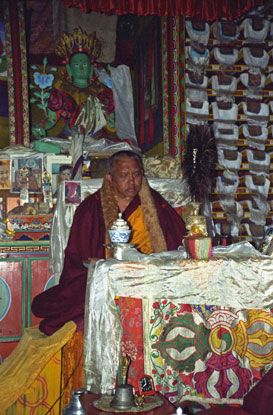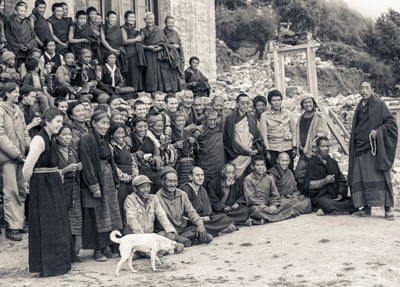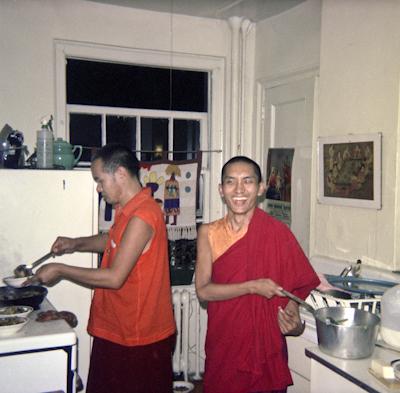Dear Friends,
Thanks for subscribing to our monthly e-letter. Feel free to share it with others!
Many thanks for your generosity and consideration to all who so kindly donated to our Saka Dawa appeal. We truly appreciate your support and couldn't do it without you. If you somehow missed the opportunity, it’s not too late! Please donate here.
In this month's issue we have a new video and podcast from the archive to share with you; the latest installment of the Big Love Audiobook Heart Project; new nyung nä teachings given by Lama Zopa Rinpoche at Lawudo; a few new translations of LYWA publications and updates from the home office. Read on and enjoy!
FROM THE VIDEO ARCHIVE: Understanding and Dealing with Death
This month from the video archive Lama Yeshe guides us through understanding and dealing with death. This timeless teaching was given during a weekend seminar on death, the intermediate state and rebirth in Geneva, Switzerland, in September 1983. LYWA has now published all the filmed sessions from this weekend on the LYWA YouTube channel. You can find these teachings available in various formats, including the free print book Life, Death, and After Death, online on our website and as an e-book, audiobook, or multimedia presentation.
Visit and subscribe to the LYWA YouTube channel to view more videos freely available from our archive. See the FPMT YouTube channel for many more videos of Lama Zopa Rinpoche’s teachings.
On the LYWA Podcast: Our Practice Is Like A Seed
 The meditation practice is like the seed. The actual body of meditation, the practice, that is like the seed and purifying the hindrances and the accumulation of merit are like the soil and water.
The meditation practice is like the seed. The actual body of meditation, the practice, that is like the seed and purifying the hindrances and the accumulation of merit are like the soil and water.
– Lama Zopa Rinpoche
This month on the LYWA podcast, Lama Zopa Rinpoche explains why we must prepare the ground of our mind with merit accumulation and karmic purification so that the seeds of our practice of listening, contemplation, and meditation can grow into realizations on the path to attain enlightenment for the sake of all mother sentient beings. These teachings were given by Rinpoche at Manjushri Institute, Cumbria, England, August 16-24, 1979. You can find the transcript here on our website.
The LYWA podcast contains hundreds of hours of audio, each with links to the accompanying lightly edited transcripts. See the LYWA podcast page to search or browse the entire collection by topic or date, and for easy instructions on how to subscribe.
BIG LOVE AUDIOBOOK HEART PROJECT
 We are happy to share another audiobook installment of Big Love: The Life and Teachings of Lama Yeshe, written by Adele Hulse. Organized by Janet Brooke, this heart project is comprised of narrations recorded by personal friends of the late Åge Delbanco (Babaji), one of Lama Yeshe's earliest students.
We are happy to share another audiobook installment of Big Love: The Life and Teachings of Lama Yeshe, written by Adele Hulse. Organized by Janet Brooke, this heart project is comprised of narrations recorded by personal friends of the late Åge Delbanco (Babaji), one of Lama Yeshe's earliest students.
This month the Big Love Heart Project brings you Chapter 8: 1970: The First Group Ordination, narrated by Chana Brooke. Chapter 8 describes how early seekers were drawn to the Lamas, how the Lamas skillfully drew them to the Dharma, and how this resulted in the first group ordination of nuns and monks.
WHAT'S NEW ON OUR WEBSITE
 This month we have posted a series of nyung nä teachings given by Lama Zopa Rinpoche at Lawudo Retreat Centre in Solu Khumbu, Nepal, June 1977. Rinpoche’s commentary includes advice on the benefits of nyung nä, the qualities of Chenrezig and meditation instructions for the practice. Read an excerpt from this new series in our monthly teaching below. You can also find more nyung nä teachings on our website, including Abiding in the Retreat book. See also Rinpoche’s Online Advice Book for further nyung nä advice.
This month we have posted a series of nyung nä teachings given by Lama Zopa Rinpoche at Lawudo Retreat Centre in Solu Khumbu, Nepal, June 1977. Rinpoche’s commentary includes advice on the benefits of nyung nä, the qualities of Chenrezig and meditation instructions for the practice. Read an excerpt from this new series in our monthly teaching below. You can also find more nyung nä teachings on our website, including Abiding in the Retreat book. See also Rinpoche’s Online Advice Book for further nyung nä advice.
We are happy to share with you the latest Italian and Portuguese translations. New Italian translations include two books by Lama Thubten Yeshe, Knowledge-Wisdom and Becoming Your Own Therapist & Make Your Mind an Ocean, published by Nalanda Edizioni. There is also a new Brazilian Portuguese translation of How Things Exist, a collection of five talks by Lama Zopa Rinpoche. This book was translated by the team at Centro Shiwa Lha, the FPMT center in Rio de Janeiro, Brazil.
We are grateful to work with so many amazing translators who make our publications and transcripts available in languages other than English. Visit our website for links to translations in eighteen languages.
We've also posted some new advices for Lama Zopa Rinpoche’s Online Advice Book. Every year we add more than 100 entries on a variety of topics, there are now more than 2,200 of Rinpoche’s advices online.
- Pray for the Highest Happiness and Peace: Rinpoche explains why we need to pray for ultimate happiness and liberation from the sufferings of samsara.
- Thanks for Organizing 100 Million Mani Retreat: In this letter, Rinpoche offers thanks to a student who arranges an annual mani retreat and says his dream is for these retreats to continue forever.
- Lifetime Practices: Lamrim, Medicine Buddha and Chenrezig Mantra: This advice was given to a student who requested lifetime practices and asked Rinpoche to be their teacher, to help and guide them.
You can always find a list of all the newly posted advices from Lama Zopa Rinpoche on our website.
New Advice from His holiness the dalai lama & updates From the home office
 Please visit the FPMT's website for more details on the new advice from His Holiness the Dalai Lama regarding the swift return of Rinpoche's reincarnation. Venerable Roger Kunsang had the opportunity to meet with His Holiness during his recent visit to Dharamsala, India. His Holiness emphasized the importance of continuing with practices as previously advised, along with protector prayers and practices outlined below.
Please visit the FPMT's website for more details on the new advice from His Holiness the Dalai Lama regarding the swift return of Rinpoche's reincarnation. Venerable Roger Kunsang had the opportunity to meet with His Holiness during his recent visit to Dharamsala, India. His Holiness emphasized the importance of continuing with practices as previously advised, along with protector prayers and practices outlined below.
Our dedicated office manager and membership coordinator, Ani Tenzin Desal, will be on her annual retreat and away from the office for the next five weeks. During this period, there will be limited shipping options available, certain book titles may be temporarily unavailable, and all requests for larger book orders will be placed on hold until her return in July. We wish Ani Desal a joyful and fulfilling retreat this year!
And if you’ve visited LamaYeshe.com recently, you may have experienced a slow response time or error message. Unfortunately, our website has been a target of internet attacks designed to discourage valid website visitors and bring down our site. We have partnered with Cloudflare to provide protection for our site and mitigate these attacks, and so we hope the situation has improved. If you experienced issues in the past few weeks, please try again! And email Jen with any questions or concerns.
As always, thank you so much for all your support. We truly couldn't do it without you! Read on for this month's teaching by Rinpoche on how to recognize the false I.
Big love,

Nick Ribush
Director
THIS MONTH'S TEACHING: Recognizing the False I
 What we should be empty of is the innate grasping at I. From the moment we’re born in the womb, we have this concrete, solid grasping at I. It’s the same when we get up in the morning, we think, “I have to go somewhere.” A very strong feeling of I is there. “Although I’m cold, I have to get up.” The I appears concrete, really existing of its own accord and we grasp at it. If someone says “You’re ridiculous, you’re too self-centered,” or “You’re a thief,” automatically, spontaneously, from the depths of the heart arises this I, which exists of its own accord. If we take precepts, we think, “I’m hungry.” A very solid I is hungry. We have this belief. If someone bashes our body, anger automatically comes up, a heavy I comes up from our heart automatically.
What we should be empty of is the innate grasping at I. From the moment we’re born in the womb, we have this concrete, solid grasping at I. It’s the same when we get up in the morning, we think, “I have to go somewhere.” A very strong feeling of I is there. “Although I’m cold, I have to get up.” The I appears concrete, really existing of its own accord and we grasp at it. If someone says “You’re ridiculous, you’re too self-centered,” or “You’re a thief,” automatically, spontaneously, from the depths of the heart arises this I, which exists of its own accord. If we take precepts, we think, “I’m hungry.” A very solid I is hungry. We have this belief. If someone bashes our body, anger automatically comes up, a heavy I comes up from our heart automatically.
This strong feeling of I as concretely existing has existed since birth. We haven’t been taught by our parents or at school, we have it even in the bardo. The innate I-grasping, believing in an inherently existing I of its own accord, swells up especially when we’re mistreated, abused or influenced by attachment. At those times, it goes rampant. What we have to annihilate is the object which our innate I-grasping hooks onto. It’s important to know what type of I that innate grasping at I hooks onto. It’s important to recognize which type of I that grasping believes in.
The basis of I, what I is labeled on, is the aggregates, of which there are only two: body and mind. Whether we make a big thing of I or not, it’s very simple, there are only two, body and mind. The root of samsara is ignorance of the voidness of the self, the grasping at self. What type of I does it grasp? What type of I does it hook onto? That is upon the mind and body, grasping onto some kind of I which concretely exists of its own accord. This is the object which the grasping at I hooks onto. It grasps at an I, which on the basis of the label, the body and mind, exists of its own accord without being dependent. If we’re starving, then we say, “I’m hungry.” A real I feels hungry, something black. Our grasping at I assumes a real I is suffering from starvation. If we check up and analyze this I, we find it is made up of the body, which is the combination of sperm and egg, and the consciousness, which comes from the previous birth. On the collection of these two, the term “I” is imputed.
If someone is ignorant of what a candle is, and they are told “This is a candle,” then they think “This is a candle.” The candle is a product of the word and material, termed “candle.” Candle is an imputation on wax and wick. Like this, the body is not I; it is just a collection of egg and sperm from the parents. If it were I, then the parents’ bodies should be I. Actually, neither the body nor the mind is I. The abidance of mind in this body is the basis of the label. This is imputed as I. This is I. Without our imputing mind, there is no I which exists of its own accord on the body and mind. There is no I which exists of its own accord without depending on the term imputed by our mind.
When we’ve eaten food and later the stomach is empty, the empty feeling is termed hungry. For this feeling, we say, “I’m hungry.” We impute “I’m hungry” on the feeling. If we check up, there’s no real I which is hungry. There’s no I which is hungry at that moment which doesn’t depend on the body and mind or on the imputation. If we try to find the I which doesn’t depend on the body and mind and on the imputation, there’s no way we’ll find it. When there’s contentment of the mind and stomach, on this basis we say “I’m full.” If we have worms and feel sick, then because of the body which is sick, the body which is the basis for the label I, we say, “I’m sick.” But there’s no real I which is sick at that moment.
What is real is the existing conventional I—the mere existence of I which is imputed by the mind on the body and mind which is the basis of the label. It’s clear that I depends on the term which is imputed on the body and mind. Depending on the basis of the label, the mind and body, can I exist? How is I dependent? I is dependent arising. How I has been arising is because it’s dependent on the basis of the label, body and mind, and on the mind which imputes the term and concept. Depending on these two, it arises—on the basis of the label, the mind and body, and on the term and concept which imputes it. Thus, it is dependent arising, it is void of inherent existence. As “I” is dependent arising, it is void of inherent existence.
If we have a good understanding of dependent arising, then thinking that I is dependent arising can induce an understanding of the non-inherent existence of I. If we have a good understanding of dependent arising and think I is dependent arising, this can stop the grasping at inherent existence of I. It stops the object of the grasping at inherent existence. Even if we don’t have a good intellectual understanding of the logic which establishes dependent arising, but if we do have a good understanding of what dependent arising means, just this will tear the object of grasping at inherent existence into pieces.
If you can’t study voidness extensively, you can study the mahamudra text by the First Panchen Lama, The Great Seal of Voidness. This contains examples from his own perception and there are ways to meditate explained at the end of the text.
“The objects of the six consciousnesses, whatever appears to the six consciousnesses, to recognize those objects relies on the right view of voidness.” These two lines contain the key to all meditation on voidness, it’s a composite of methods. To realize voidness, we have to know what things are empty of. We say the realization of voidness is difficult. That is because we can’t recognize what is to be refuted regarding the objects of the six senses. Because we can’t recognize what the objects appearing to the six consciousnesses are empty of, we say the realization of voidness is difficult. Whatever objects appear to the six consciousnesses, to know what exists and what doesn’t, to know what is to be refuted, is the most important factor. The essence or importance of voidness relies on recognizing how the objects of the six consciousnesses appear. This is the secret of the realization of voidness. Of the things which appear to the consciousnesses, what is to be refuted is very small, but it’s so important, like the secret key to a treasure. If we can’t recognize it, then there’s no way to realize voidness. To unknot the thread which has many knots, we must know where to start in order to loosen them. To say “Let’s burn it” is ridiculous. We must unknot it.
The most important factor is the ability to recognize what is to be refuted. This recognition is extremely difficult. To recognize this we need the background of extensive collection of merits from guru yoga and guru devotion. Without the support of extensive merits, there’s no way to recognize this. If we can properly collect merits and purify, [by practicing] guru yoga and guru devotion, then if we don’t know, there is also extensive reasoning, as explained in the texts.
Try to check up how the object of innate grasping of I appears to you. When you find it, feel I is something concrete, existing of its own accord without depending on the basis of the label, the mind and body, don’t lose it. Rather, contemplate it, thinking, “This is the false I which doesn’t exist.” Sometimes there comes a vision that you are losing. When the I that appears to you is lost, you feel the subject, yourself, is getting lost and you experience that there’s nothing to hold onto, to grasp onto. Those who are intelligent won’t be terrified of voidness, but will experience immense bliss. Those who are not intelligent, will be terrified.
After recognizing the false I, when we have the experience of voidness, we feel then that before we were ridiculous, we were stuck on something worthless. Before, we were stuck on something which seemed big, but it is worthless. When we recognize what is to be refuted, at that time all things which appear to us appear fresh, like something we’ve not seen before. It’s a different perception of things, like reaching a new country.
Excerpted from the third discourse in a series of nyung nä teachings given by Lama Zopa Rinpoche at Lawudo Retreat Centre, Solu Khumbu, Nepal in June 1977. Edited by Ven. Ailsa Cameron and Sandra Smith.































